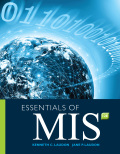
Explanation of Solution
Major technologies used in business:
- Hardware is the physical component to connect with the
operating system . These computer hardware’s like mainframe computers, personal computers, supercomputers, workstations, and grid computers. - The data storage devices used to store data in the devices. These data storage devices like magnetic disk, optical disc, magnetic tapes, and storage networks are used in business.
- The input and output devices are used to communicate with the system with some peripherals. Input devices includes keyboard, mouse, touch screen, pen based input, scanner, and other input devices. Output devices include monitor, printers, and audio output.
- The hardware trends used in business today are nanotechnology, cloud computing based technology, mobile digital platform, grid computing, cloud computing, and so on.
Types of computers available to business today:
There are various types of computers available in business today is as follows:
- Personal computers
- Workstations
- Mainframes
- Super computers
- Servers
- Grid computing
Personal computers:
It is the desktop computers used for a person or peoples in small business. It handles all the basic functionalities compared to server computers.
Workstations:
These computers have a powerful functionalities and graphical capabilities than PCs. It is used in designing work with powerful graphic tool and capabilities.
Mainframes:
It is the large capacity computers with high performance which process the vast amount of data quickly.
Super computers:
It is an advanced machine which is used to solve the complicated calculations, millions of measurements with multiple variables, and thousands of equations.
Servers:
This type of computers used to share the files, software, peripheral devices, or other network related resources through
Grid computing:
It is the remote computing system which is connected to the single network to virtual super computer by combining the computational power of all computers in a grid.
Client and server model:
- The two or many computers are connected with each other through network for data processing is called distributed processing. The client/server is one of the distributed processing which passes the data between client and server.
- Both client and server is the computer system which works on internet and connected with each other. The client is called use and server provides the service to the user.
- The client system access the client part of the application and server stores the information and share the data with network activities.
Difference between two-tiered and n-tier client/server architecture;
| Two-tier client/server architecture | n-tier client/server architecture |
| It has two computer systems. One system used for client system and another one is used for server system. | It has multiple numbers of clients and servers. |
| The process of data splits between two types of machines. | The process is splits between multiple number of clients and servers. |
| It is the simple system. | It is the complex system. |
Secondary storage media:
The storage device is places internal or external to the computer is known as secondary storage media. The list of secondary storage media is as follows:
- Magnetic disk
- Optical disk
- Magnetic tape
- Storage networks
Magnetic disk:
Magnetic disks are most widely used secondary device which includes floppy and hard disks. These magnetic disks are convenient to use, permit the direct access with individual records, and provide fast access speed.
Strengths of magnetic disk:
- The magnetic disk supports the direct access to the data which is not possible in magnetic tapes.
- It is light weighted and easy portable form one to another place.
- Data transfer rate is higher than the magnetic tapes.
Limitations of magnetic disk:
- It is costlier than magnetic tapes.
- Difficulty to maintain data securely.
Optical disk:
It has the greater density than the magnetic disks to store the vast quantity of data such as documents and reference materials.
Strengths of optical disk:
- It uses the laser technology for large quantity of data such as audio, video, and images.
- The cost of the optical disk is low and provides the extensive storage
- It is portable.
Limitations of optical disk:
- The data in optical disk can be editable in 3 to 4 times only. Because, it has limited editable accessibility in optical disk...
Want to see the full answer?
Check out a sample textbook solution
 Database System ConceptsComputer ScienceISBN:9780078022159Author:Abraham Silberschatz Professor, Henry F. Korth, S. SudarshanPublisher:McGraw-Hill Education
Database System ConceptsComputer ScienceISBN:9780078022159Author:Abraham Silberschatz Professor, Henry F. Korth, S. SudarshanPublisher:McGraw-Hill Education Starting Out with Python (4th Edition)Computer ScienceISBN:9780134444321Author:Tony GaddisPublisher:PEARSON
Starting Out with Python (4th Edition)Computer ScienceISBN:9780134444321Author:Tony GaddisPublisher:PEARSON Digital Fundamentals (11th Edition)Computer ScienceISBN:9780132737968Author:Thomas L. FloydPublisher:PEARSON
Digital Fundamentals (11th Edition)Computer ScienceISBN:9780132737968Author:Thomas L. FloydPublisher:PEARSON C How to Program (8th Edition)Computer ScienceISBN:9780133976892Author:Paul J. Deitel, Harvey DeitelPublisher:PEARSON
C How to Program (8th Edition)Computer ScienceISBN:9780133976892Author:Paul J. Deitel, Harvey DeitelPublisher:PEARSON Database Systems: Design, Implementation, & Manag...Computer ScienceISBN:9781337627900Author:Carlos Coronel, Steven MorrisPublisher:Cengage Learning
Database Systems: Design, Implementation, & Manag...Computer ScienceISBN:9781337627900Author:Carlos Coronel, Steven MorrisPublisher:Cengage Learning Programmable Logic ControllersComputer ScienceISBN:9780073373843Author:Frank D. PetruzellaPublisher:McGraw-Hill Education
Programmable Logic ControllersComputer ScienceISBN:9780073373843Author:Frank D. PetruzellaPublisher:McGraw-Hill Education





